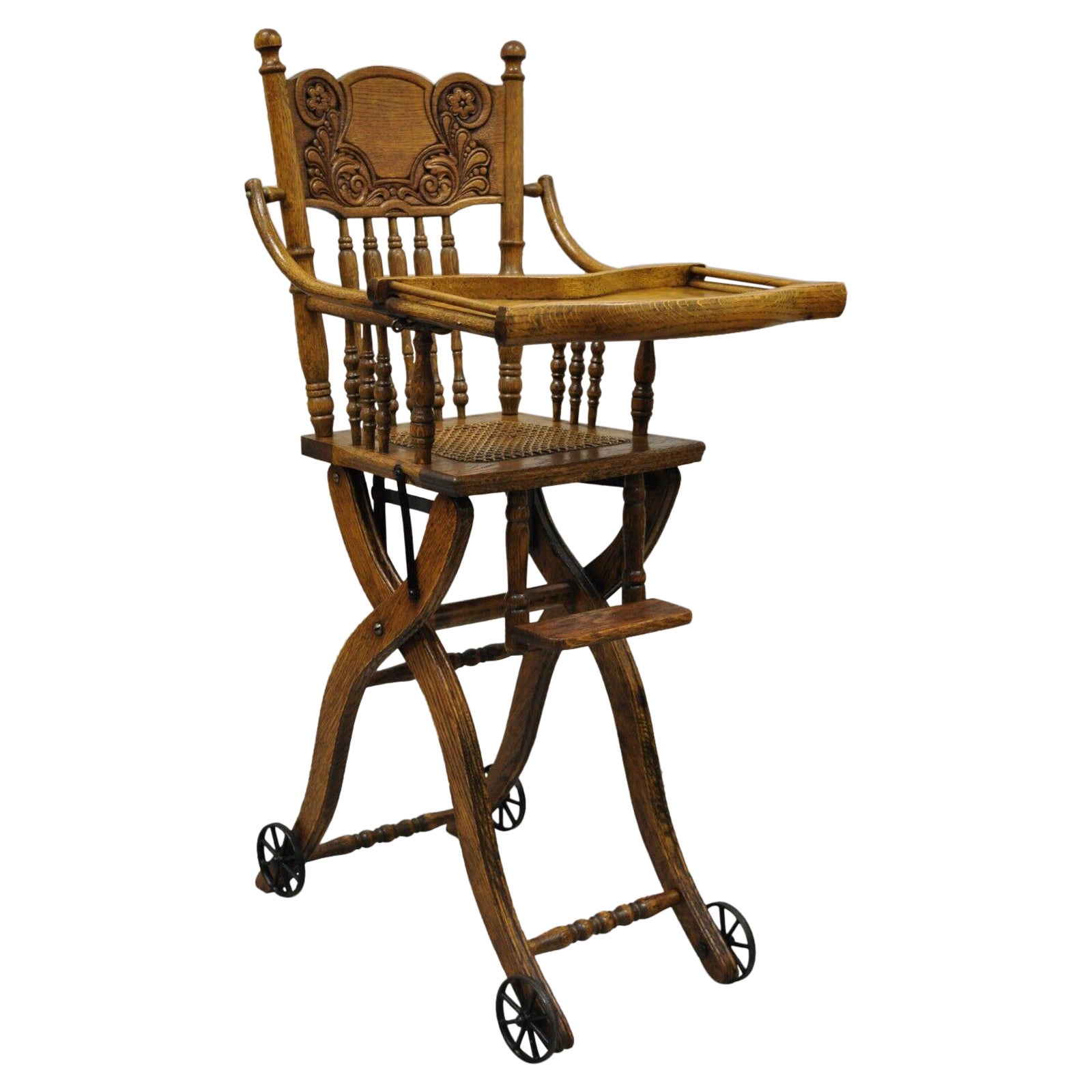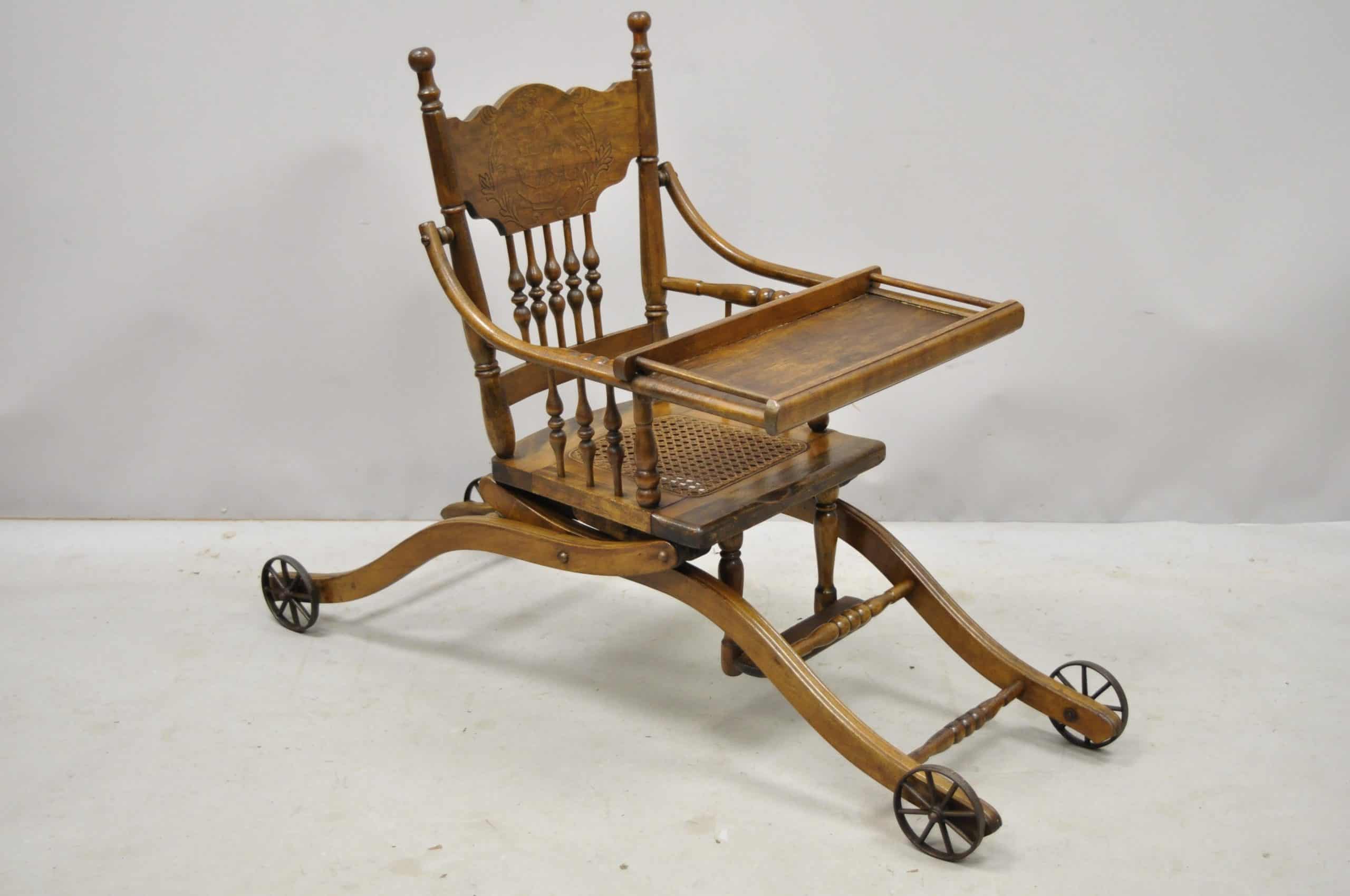Historical Context and Evolution of Antique High Chair Strollers

The evolution of the high chair stroller, a unique blend of functionality and design, reflects a fascinating journey through the history of childcare and furniture design. These versatile pieces, combining the feeding convenience of a high chair with the mobility of a stroller, have evolved significantly over time, reflecting changing societal needs and technological advancements.
Early Origins and Design Features
The origins of the high chair stroller can be traced back to the late 19th century, with the advent of the high chair itself. Early high chairs were typically wooden, often featuring a simple design with a high seat and a tray for feeding. The concept of mobility was introduced in the early 20th century, with the development of the first high chair strollers.
These early models were often characterized by their sturdy construction, typically made of wood or metal. The stroller component was often a simple wheeled base, allowing for limited maneuverability. Features such as adjustable height and folding capabilities were rare, and the focus was primarily on providing a safe and elevated seating position for infants and toddlers.
Notable Manufacturers and their Contributions, Antique high chair stroller value
Several notable manufacturers played a key role in shaping the development of the high chair stroller.
- The Heywood-Wakefield Company, a prominent furniture manufacturer, introduced a high chair stroller model in the early 20th century. This model featured a sturdy wooden frame with a high chair seat and a wheeled base, showcasing a classic design that emphasized durability and functionality.
- The Gerstner Chair Company, another prominent furniture manufacturer, also contributed to the evolution of the high chair stroller. Their models were known for their innovative features, such as adjustable height and folding capabilities, reflecting a shift towards greater convenience and portability.
Evolution of Features and Functionality
Over time, high chair strollers underwent significant design improvements, incorporating new features and functionalities to meet evolving needs.
- Adjustable Height: Early models were often fixed in height, limiting their adaptability to different table heights. Later models incorporated adjustable height features, allowing for greater versatility and convenience.
- Folding Mechanisms: Early models were typically bulky and difficult to store. The introduction of folding mechanisms revolutionized the design, allowing for greater portability and space-saving storage.
- Wheels and Maneuverability: Early models featured simple wheeled bases, providing limited maneuverability. Later models incorporated larger wheels and improved steering mechanisms, enhancing ease of movement and allowing for greater control in various environments.
- Safety Features: As safety concerns increased, high chair strollers began incorporating features such as safety harnesses, tray locks, and sturdy construction to ensure the well-being of infants and toddlers.
Impact of Materials and Technology
The evolution of high chair strollers was also influenced by advancements in materials and technology. The introduction of lightweight metals, such as aluminum, allowed for the development of lighter and more maneuverable models. The use of plastics and other durable materials further enhanced the durability and functionality of these versatile pieces.
Shifting Design Trends
The design of high chair strollers has also reflected changing societal trends and aesthetic preferences. Early models were often characterized by a classic and functional design, emphasizing durability and practicality. Later models incorporated more contemporary designs, incorporating elements of style and aesthetics alongside functionality.
Factors Influencing Value and Collectibility

The value of antique high chair strollers, like any collectible, is influenced by a complex interplay of factors. Understanding these factors is crucial for both collectors and those seeking to sell or appreciate these historical artifacts.
Materials and Their Impact on Value
The materials used in the construction of antique high chair strollers significantly impact their value. High-quality materials, such as solid wood, metal, and leather, are generally more desirable and command higher prices.
- Wood: Antique high chair strollers were often crafted from various hardwoods, including oak, mahogany, and cherry. These woods are known for their durability, beauty, and ability to age gracefully. Strollers made from these woods, especially those with intricate carvings or decorative details, are highly sought after by collectors.
- Metal: Metal, such as iron or steel, was frequently used for the frame, wheels, and other structural components. The quality and craftsmanship of the metalwork, including the type of finish (painted, polished, or lacquered), can significantly affect value. Strollers with elaborate metalwork, like intricate scrollwork or decorative castings, are often more valuable.
- Leather: Leather was commonly used for upholstery, straps, and other accents. The condition of the leather, its type (e.g., calfskin, pigskin), and the presence of original stitching or hardware all contribute to its value.
Design Elements and Their Influence on Desirability
Beyond the materials used, the design elements of an antique high chair stroller play a significant role in its desirability and rarity.
- Style and Period: The specific style of the stroller, such as Victorian, Art Deco, or Mid-Century Modern, can impact its value. Strollers from certain periods, like the Victorian era, are often highly sought after due to their unique designs and historical significance.
- Functionality and Features: Features like adjustable seating positions, folding mechanisms, or innovative design elements can increase a stroller’s value. Strollers with unique features or those that demonstrate a high level of craftsmanship are often more desirable.
- Rarity and Limited Production: Strollers produced in limited quantities or those with unique features are often more valuable. The scarcity of a particular model can significantly increase its desirability among collectors.
Condition, Provenance, and Historical Significance
The condition, provenance, and historical significance of an antique high chair stroller are crucial factors influencing its value.
- Condition: The overall condition of a stroller, including the state of preservation, any repairs or restoration, and the presence of original components, greatly affects its value. Strollers in excellent condition with minimal wear and tear are highly sought after.
- Provenance: The history of a stroller, including its previous owners and any documented information about its use, can significantly increase its value. Strollers with a strong provenance, such as those that belonged to a notable family or were used in a historical event, are often considered more valuable.
- Historical Significance: Strollers that have historical significance, such as those associated with a particular event or person, are highly valued by collectors and institutions. These strollers can offer a unique window into the past and provide valuable insights into the history of childhood and family life.
Identifying and Appraising Antique High Chair Strollers: Antique High Chair Stroller Value

Now that we’ve explored the history and factors that influence the value of antique high chair strollers, let’s delve into the practical aspects of identifying and appraising these unique collectibles. Understanding the key characteristics, determining authenticity, and recognizing restoration techniques are crucial steps in determining the true value of your antique high chair stroller.
Identifying Key Characteristics
Identifying key characteristics is essential for accurately assessing the age and value of an antique high chair stroller. This involves examining various aspects, including manufacturers’ marks, design features, and materials.
- Manufacturers’ Marks: Identifying the manufacturer is a crucial step in appraising an antique high chair stroller. Look for stamps, labels, or tags that might indicate the manufacturer’s name, location, or a specific model number. Many manufacturers, like the renowned “The Baby Carriage Company,” were known for their distinctive designs and markings.
- Design Features: Design features can offer valuable clues about the age and origin of the stroller. For instance, early strollers often featured intricate hand-painted designs or detailed carvings, while later models might incorporate simpler designs. The presence of specific features like adjustable seats, folding mechanisms, or unique wheel configurations can also help pinpoint the stroller’s era.
- Materials: The materials used in the construction of the stroller can provide valuable insights into its age and origin. Early strollers were often crafted from solid wood, metal, or wicker, while later models might utilize lightweight materials like aluminum or plastic. Examining the quality of the materials, the craftsmanship, and the presence of any unique materials can reveal important details about the stroller’s history.
Determining Age and Authenticity
Determining the age and authenticity of an antique high chair stroller requires careful examination and a thorough understanding of historical context.
- Documentation: If available, original documentation, such as sales receipts, manuals, or family records, can provide valuable information about the stroller’s age and origin. These documents can confirm the manufacturer, date of purchase, and any unique features associated with the specific model.
- Comparative Research: Comparing the stroller to known examples from specific periods can help determine its age. Researching online databases, antique guides, and auction records can provide valuable information about similar strollers and their estimated values.
- Expert Appraisal: For a more comprehensive appraisal, consider consulting with a qualified antique appraiser specializing in baby carriages or antique furniture. An experienced appraiser can examine the stroller in detail, identify any unique features, and provide a professional assessment of its authenticity and market value.
Common Restoration Techniques and Their Impact on Value
Restoration techniques can enhance the appearance and longevity of an antique high chair stroller. However, it’s crucial to understand the impact of restoration on value.
- Authenticity: Restoration techniques should aim to preserve the stroller’s original character and authenticity. Avoid unnecessary modifications or alterations that might diminish its historical value.
- Materials: Use materials that closely match the original construction. For example, using period-appropriate paint, fabric, or wood finishes can help maintain the stroller’s historical integrity.
- Documentation: Document all restoration work performed, including the materials used and the methods employed. This documentation can be valuable for future appraisal or sale.
“A well-restored antique high chair stroller can be a beautiful and valuable addition to any collection. However, it’s crucial to prioritize authenticity and preservation over purely aesthetic enhancements.”
Antique high chair stroller value – The value of antique high chair strollers can fluctuate based on factors such as age, condition, and brand. Decorative elements, such as those found in little mermaid high chair decorations , can also influence value. For example, a high chair stroller with intricate carvings or hand-painted details might command a higher price than a more basic model.
The value of antique high chair strollers can vary greatly depending on factors like age, condition, and brand. Some sought-after models, such as the lehman babyguard high chair , are known for their durability and vintage appeal, potentially fetching higher prices on the collectors’ market.
However, a thorough assessment of the specific model and its overall condition is essential to determine its true value.
